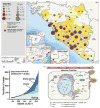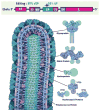Strategies in Ebola virus disease (EVD) diagnostics at the point of care
- PMID: 28440096
- PMCID: PMC5653233
- DOI: 10.1080/1040841X.2017.1313814
Strategies in Ebola virus disease (EVD) diagnostics at the point of care
Abstract
Ebola virus disease (EVD) is a devastating, highly infectious illness with a high mortality rate. The disease is endemic to regions of Central and West Africa, where there is limited laboratory infrastructure and trained staff. The recent 2014 West African EVD outbreak has been unprecedented in case numbers and fatalities, and has proven that such regional outbreaks can become a potential threat to global public health, as it became the source for the subsequent transmission events in Spain and the USA. The urgent need for rapid and affordable means of detecting Ebola is crucial to control the spread of EVD and prevent devastating fatalities. Current diagnostic techniques include molecular diagnostics and other serological and antigen detection assays; which can be time-consuming, laboratory-based, often require trained personnel and specialized equipment. In this review, we discuss the various Ebola detection techniques currently in use, and highlight the potential future directions pertinent to the development and adoption of novel point-of-care diagnostic tools. Finally, a case is made for the need to develop novel microfluidic technologies and versatile rapid detection platforms for early detection of EVD.
Keywords: Ebola virus; diagnostics; immunoassay; microfluidics; polymerase chain reaction.
Conflict of interest statement
Authors declare no financial conflict of interest.
Figures






Similar articles
-
An Outbreak of Ebola Virus Disease in the Lassa Fever Zone.J Infect Dis. 2016 Oct 15;214(suppl 3):S110-S121. doi: 10.1093/infdis/jiw239. Epub 2016 Jul 11. J Infect Dis. 2016. PMID: 27402779 Free PMC article.
-
Comparative Evaluation of the Diagnostic Performance of the Prototype Cepheid GeneXpert Ebola Assay.J Clin Microbiol. 2016 Feb;54(2):359-67. doi: 10.1128/JCM.02724-15. Epub 2015 Dec 4. J Clin Microbiol. 2016. PMID: 26637383 Free PMC article.
-
Diagnostics in Ebola Virus Disease in Resource-Rich and Resource-Limited Settings.PLoS Negl Trop Dis. 2016 Oct 27;10(10):e0004948. doi: 10.1371/journal.pntd.0004948. eCollection 2016 Oct. PLoS Negl Trop Dis. 2016. PMID: 27788135 Free PMC article. Review.
-
Lateral Flow Immunoassays for Ebola Virus Disease Detection in Liberia.J Infect Dis. 2016 Oct 15;214(suppl 3):S222-S228. doi: 10.1093/infdis/jiw251. Epub 2016 Jul 20. J Infect Dis. 2016. PMID: 27443616 Free PMC article.
-
Towards detection and diagnosis of Ebola virus disease at point-of-care.Biosens Bioelectron. 2016 Jan 15;75:254-72. doi: 10.1016/j.bios.2015.08.040. Epub 2015 Aug 20. Biosens Bioelectron. 2016. PMID: 26319169 Free PMC article. Review.
Cited by
-
Microfluidic System for Detection of Viral RNA in Blood Using a Barcode Fluorescence Reporter and a Photocleavable Capture Probe.Anal Chem. 2017 Nov 21;89(22):12433-12440. doi: 10.1021/acs.analchem.7b03527. Epub 2017 Nov 7. Anal Chem. 2017. PMID: 29073356 Free PMC article.
-
Early detection of Ebola virus proteins in peripheral blood mononuclear cells from infected mice.Clin Proteomics. 2020 Mar 17;17:11. doi: 10.1186/s12014-020-09273-y. eCollection 2020. Clin Proteomics. 2020. PMID: 32194356 Free PMC article.
-
Development of an Enzyme-Linked Immunosorbent Assay to Determine the Expression Dynamics of Ebola Virus Soluble Glycoprotein during Infection.Microorganisms. 2020 Oct 6;8(10):1535. doi: 10.3390/microorganisms8101535. Microorganisms. 2020. PMID: 33036194 Free PMC article.
-
Circulating tumor cell isolation, culture, and downstream molecular analysis.Biotechnol Adv. 2018 Jul-Aug;36(4):1063-1078. doi: 10.1016/j.biotechadv.2018.03.007. Epub 2018 Mar 17. Biotechnol Adv. 2018. PMID: 29559380 Free PMC article. Review.
-
Internet of medical things (IoMT)-integrated biosensors for point-of-care testing of infectious diseases.Biosens Bioelectron. 2021 May 1;179:113074. doi: 10.1016/j.bios.2021.113074. Epub 2021 Feb 6. Biosens Bioelectron. 2021. PMID: 33596516 Free PMC article. Review.
References
-
- Akter F, Mie M, Kobatake E. DNA-based immunoassays for sensitive detection of protein. Sens Actuators B Chem. 2014;202:1248–1256.
-
- Alazard-Dany N, Terrangle MO, Volchkov V. Ebola et Marburg: les hommes contre-attaquent. M/S: Méd Sci. 2006;22:405–410. - PubMed
-
- Asghar W, Ilyas A, Deshmukh RR, Sumitsawan S, Timmons RB, Iqbal SM. Pulsed plasma polymerization for controlling shrinkage and surface composition of nanopores. Nanotechnology. 2011;22:285304. - PubMed
Publication types
MeSH terms
Grants and funding
LinkOut - more resources
Full Text Sources
Other Literature Sources
Medical
